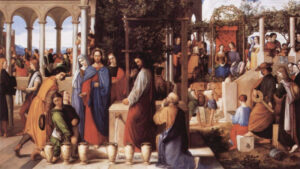
Many mysteries are hidden in the event of the wedding at Cana.
No less significant is the way in which Christ works this miracle. In fact, it is God’s omnipotence alone that decides when the great hour of the work of redemption will strike and the Redeemer will reveal Himself to the world.
Up to now he has never worked a miracle and has never appeared in public. And now something unheard of happens: in view of the misery of lost humanity, which has no more wine of grace, Mary asks her Son not to delay any longer and not to wait any longer.
To grasp the full implications of this event, we must consider the Lord’s peculiar response. He, who for 30 years had called her “Mother”, now suddenly calls her “Woman”.
Then he asks a question about the deeper meaning of which even today the best commentators of the Scriptures do not agree: “What is between me and you?” And finally, the apparent rejection: “My hour has not yet come”.
This very statement proves how Christ evaluates the beginning of his miraculous life: for it is about nothing less than the first “sign” of his divine power and divine mission, the first revelation of his glory and the foundation of the faith of his disciples (Jn 2:11).
Even more, when Christ speaks of his “hour”, he has in mind his whole mission: the proclamation of the truth, the salvation of souls, and the restoration of the Father’s glory through His holy life, but above all through His suffering and death on the cross. That is why, on the eve of his Passion, he says: “Father, the hour has come” (Jn 17:1).
Now we can understand the scope of Mary’s request to her divine Son and the deeper meaning of the wedding at Cana: just as it once depended on her “fiat” that the God-man became man, so it now depends on her that the God-man begins the long three-year “hour” of redemption.
Without this conviction that the time of this beginning had now come and without the insight that she should take the initiative according to God’s will, Mary would never have asked for this miracle.
Yet she is fully aware of what she is asking for here: just as the old Eve pushed Adam onto the path of destruction, so the new Eve, as it were, pushed the new Adam onto the path of redemption, onto the path to Calvary: in Cana it is the beginning of the “signs”, at Golgotha “all is accomplished”.
At Cana, Mary stands before Jesus and asks him; at Golgotha, Mary stands before Jesus and sacrifices him. In Cana Jesus calls her “woman”, on Golgotha he exclaims: “Woman, behold your Son”. At Cana Jesus gives the wine, at Golgotha Jesus gives his blood.
In Cana his “hour” began, on Golgotha his “hour is fulfilled”. At Cana Jesus sanctifies the marriage of men, at Golgotha the “marriage of the Lamb” is celebrated.
In the three supreme moments, the Incarnation, the first miracle (the beginning of public life) and the Cross, it is always Mary, the new Eve, who stands at the side of her Son, the new Adam, with whom she is completely united in the work of redemption.


